Discover the secrets behind Gravity's mindblowing VFX
Well-grounded VFX house Framestore combines zero-gravity and 3D depth in this FX extravaganza.
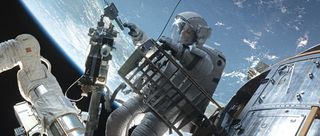
Some 3D movies are bogged down with effects; others are light fare. But Alfonso Cuarón's Gravity, set in the weightlessness of space, is a rare union of ethereal CG work that unifies more than practical shoots with digital trickery. This breathtaking film carries you away without ever hinting that pixels are your mode of travel.
Driven by the facial acting of Sandra Bullock and her CG spacesuit, the two are joined into one character struggling to survive, assisted by a veteran astronaut (George Clooney) - and the artists of Framestore. Two of those artists, CG supervisor Chris Lawrence and animation supervisor Max Solomon share what helped to make this film such a stellar success.
Lawrence and Solomon joined the project in 2009, during the Atlantis Hubble previz stage."By the time Max and I came on," says Lawrence, "there were lots of things we didn't know about the movie and a few things we did. One was it was going to have super long takes. The other was Alfonso wanted it to be set in reality. He didn’t want people to feel like they were watching CG, he wanted it to look photographic and be indistinguishable from NASA footage."
Alfonso wanted it to be set in reality. He didn’t want people to feel like they were watching CG
Solomon, working with senior animation supervisor David Shirk, combined their digital and animation skills, utilising Shirk's CG feature film experience with Solomon's knowledge of visual effects. "We complemented quite well. Gravity is a hybrid: it's partly live action, but is similar to a CG movie in many respects. Very large parts of it are fully CG."
When Alfonso pitched the film, it wasn't realised how much CG that would turn out to be. Although early tests were done using more traditional shooting methods such as actors on wire rigs and building practical sets, it soon became clear that the standard methods just weren't going to work. The challenges of weightlessness and characters spinning off into the darkness were not something the actors could achieve practically. As so many times before, digital effects became the silent star that pulled the film together.
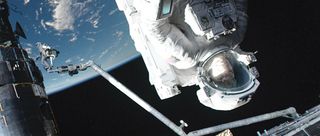
Previz development
While previz was moving forward, the production had a few bumps. Initially the film was with Universal, and then Warner Bros picked it up. It soon became obvious previz was the only way to develop the shoot methodology of this film.
Solomon says: "They were excited by the previz and pumped more money into it. We started doing storyboards, a few more artists including myself joined the previz team, and started to previz more sequences."
Get the Creative Bloq Newsletter
Daily design news, reviews, how-tos and more, as picked by the editors.
By the end of 2010, about 30 previz animators were on board and by February they had pretty much blocked all the CG sequences - over two thirds of the film. The work the team did was essential; what is seen on the screen is very similar to the previz that was delivered. To find a way to create the scenes digitally, the actors spinning in space were calculated during two months of techviz "because we didn't want them throwing up all over the place", laughed Solomon.
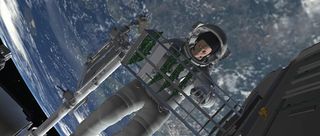
The process had to be reverse-engineered so that rather than the actor making these extreme moves, it was the camera. "But there were physical constraints on how fast and how dynamic that motion could be in the shoot, because there were limitations to how fast the robot could move and how fast the actors could be spun."
Shooting methodologies
Executing the practical shoot meant using several methodologies. All of them needed slightly different types of prep and a full, detailed previz - more detailed than Framestore was traditionally used to doing because they needed to calculate the motion, timing and dynamics to get the ballistics to feel right. One method had the actors on wires or on a dolly.
"There are some amazing rigs that let you rotate 360 degrees around on a gimble," says Lawrence. "If you've ever been at a fairground where you can do that kind of stuff, it's really disorientating because the forces of gravity are so strong; it pulls you all over the place."
But in space you are weightless, and the experience is very different. "One of the reasons we veered away from those kinds of rigs was they would have drastically altered the performance of the characters. Shooting on a more upright axis was going to give us the emotional performance we were going for." That was a key constraint, and why so much CG was necessary.
"But we did have to spin the actors around a bit. In the previz, we would have them moving on a yoke at 40° with a camera on a robot spinning over their heads, to make it seem like they were actually spinning around," says Lawrence.
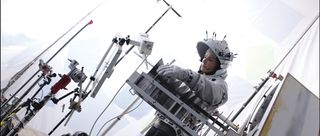
Another methodology was to use a robot camera on a long dolly with a lightbox; the former is similar to the car manufacturing robots with a mechanical arm and a camera on the end. The latter is a huge box, much like a concert stadium LED display, folded around the actor. The actor was strapped into a tilt rig, which could spin them around 180 degrees and tilt them 45 degrees to either side. The actors wore space suits and gloves, plus helmets covered with LED sticks to aid the tracking process. There was no visor in the helmet; a CG visor and reflections were added later in post-production.
The lightbox acted as a virtual digital environment so the two actors could see the environment they were interacting with. The advantage is you can safely create the spinning light illusion without using heavy practical lights. Debris would swoop past them and they had to duck and dive or grab onto things. "That was an innovative thing to be doing and required a lot of upfront preparation in order to realise it," recalls Lawrence.
The set robots and lightbox were being built in parallel, and Solomon's team was sending the techviz down to set and running it through tests. The film started shooting in April. It started slowly at first, then built momentum as the shooting methodologies were finessed, with all the key collaborators in Framestore's building working on the movie together.
CG replacements
After filming, the practical suits and helmets were replaced with CG versions, leaving only the actors' heads and helmet interiors. The join between the live-action orientation and the CG replacement had to be accurate down to the pixel so no matter what size screen or how close the camera, there was no visible slippage between the two. The animators needed to adhere to the actor's restricted movement while perfectly joining a character that was roughly four-fifths CG and one-fifth live action.
This challenge was particularly daunting in the opening scene. The debris storm hits while Sandra's character is strapped to the Atlantis Hubble’s robotic arm. As the ship is destroyed, she’s trying to avoid debris as the Hubble spins wildly over her head. Her CG character is tethered around the waist and has the freedom to twist, bend her knees and duck to avoid collisions, all relative to camera.
But during the practical shoot, Sandra wasn't moving relative to the camera and although she was at an angle, due to health and safety reasons she was physically strapped to a board and couldn't move anything below her shoulders. Seamlessly joining the opposing movements, the live action of Sandra's head and helmet interior to the CG suit and helmet exterior, meant the chest area was the only place with enough elasticity of movement to hide discrepancies.
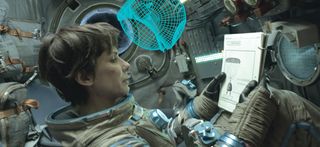
Framestore attempted to use mocap to mimic weightlessness but soon realised it was impossible to capture earth-bound mocap without feeling influenced by gravity. It was also difficult for the mocap artists to have any context of the scene they were trying to recreate.
"When we captured mocap we had Sandra's performance looping in front of the actor, over and over, and we tried to do a physical performance that matched Sandra's facial performance. But as we couldn't have them spinning in space or stuff flying past them as it was going to do in the film, they were almost as blind as Sandra was."
Although nearly the entire film was mocapped, Solomon's team ended up not using any of it, finding it useful as reference instead. Ragdoll simulation was of little help; the results were too similar to crash test dummies and didn't portray that someone was inside the suit fighting against the motion or struggling to regain control.
Solid landing
In the end, more believable results came from using keyframing along with simulations for cloth, tethers and hooks. According to Solomon, keyframing combined with Bullock's facial performance meant that "the timings, the nuance of what she did, was something we used a lot".
There was also the temptation of animators to over-articulate the performance. "When you look at George or Sandra, their performance is minimal, very controlled and efficient, so that every movement counts. That was a learning curve, just making people realise it was about finding a strong pose, then just keeping the action alive, making it feel organic, while avoiding unnecessary motion."
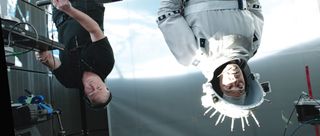
Very few directors are good at making the VFX sit into the film as just another element of the live action. "I think that is what is special about Gravity," says Solomon. "As a space film it doesn’t feel like a VFX film, it feels more like a documentary. That was always something Alfonso stipulated from the beginning, that we were a fly-on-the-wall camera crew following these astronauts through their ordeal." And that is what's so seductive about the film: it makes space seem exciting and scary, but also tricks you into thinking that it’s real.
Words: Renee Dunlop
This article originally appeared in 3D World issue 177.

Thank you for reading 5 articles this month* Join now for unlimited access
Enjoy your first month for just £1 / $1 / €1
*Read 5 free articles per month without a subscription

Join now for unlimited access
Try first month for just £1 / $1 / €1
The Creative Bloq team is made up of a group of design fans, and has changed and evolved since Creative Bloq began back in 2012. The current website team consists of eight full-time members of staff: Editor Georgia Coggan, Deputy Editor Rosie Hilder, Ecommerce Editor Beren Neale, Senior News Editor Daniel Piper, Editor, Digital Art and 3D Ian Dean, Tech Reviews Editor Erlingur Einarsson and Ecommerce Writer Beth Nicholls and Staff Writer Natalie Fear, as well as a roster of freelancers from around the world. The 3D World and ImagineFX magazine teams also pitch in, ensuring that content from 3D World and ImagineFX is represented on Creative Bloq.
